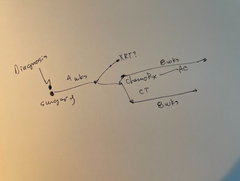What’s in this newsletter:
What is the standard of care? As a patient, why does it matter?
Establishing (re-designing morning & evening rituals)
Nerd fact of the week - Research on habit formation
What’s next: Paula Kim’s podcast as a caregiver to pancreatic cancer patients
What is the standard of care? As a patient, why does it matter?
Last week we interviewed Patrick Delaney, the Executive Director of the NCCN Foundation. Pat joined the NCCN team in 2021 and is a well-rounded professional with over 30 years of experience in management, strategic planning, sales, change management, government relations, fundraising and constituent care.
The key takeaways from our podcast are:
The NCCN clinical practice guidelines are used by oncologists worldwide and downloaded more than 13 million times.
The NCCN Foundation adapts these guidelines so the language and presentation can be understood by someone without medical training.
This understanding empowers patients and caregivers to ask pointed questions to their healthcare team.
These resources are FREE OF CHARGE for patients at nccn.org/patients.
Establishing (re-designing) morning rituals
On January 10th, 2020 I was formally diagnosed with breast cancer. I had known a few weeks prior that it was coming, and yet, that phone call is akin to a sucker-punch that knocks the wind out of you. After a few hours of recovery from that punch, my brain started to plan. Somewhere deep within my unconscious the hunt for the new normal began. Chemotherapy started soon enough, and my life was jolted into a 3 week cycle. I insisted that chemo begin on a Friday, so I’d have the weekend to recover. Thus, in February 2020, my physical body began to cycle. Get hit on a Friday, and for the next 3 weeks my body would break, recover, heal, and get back up for the next wave. Thus began my need for new rituals. It started with the morning ritual. The need to take care of my body and my mind. There was a flurry of trying to establish new regimens to take care of myself. These weren’t one-off activities, but ones that would repeat for days, weeks, months and years.
At first, it was the medications that drove it. Very quickly I added a series of activities that supported (almost) all parts of my body. I’d start with my head and go down to my toes. I massaged ointments, oils, balms, and lotions, took oral medications, and bathed in epsom salts, etc. Then I added in the need to take care of my mind. I started meditating, and doing yoga.
Over the last two years, the specifics of my morning ritual have evolved and morphed. Which part of my body I give special attention to has changed. The need for the ritual has remained.
This month, I find myself once again redesigning my morning ritual. Here is where I’ve landed.


There you have it, my revised, re-designed morning ritual for the second half of 2022. Some are experiments, others continuation of habits from the past, and some are just for pleasure.
The morning ritual has become a sacred part of my day. Days I miss it, I struggle. I struggle because the morning rituals center me. They ground me, and my family. Some days it feels like a lot of time to dedicate to “non-work”, but I have come to realize that without my morning rituals I feel sluggish, overwhelmed, and off-kilter. My morning rituals didn’t start from a productivity-hack, it started from a place of necessity. It has, not surprisingly, become essential to my productivity. When I start feeling off-balance, the first thing I look at is how well have my morning rituals been? I start there. If I can fix one thing, it’s the morning ritual.
Respond to this and tell us what your morning rituals are? What are some activities that are a part of your morning ritual?
Nerd fact of the week
We’ve summarized one of the lessons from James Clear’s book called Atomic Habits.
Here are some tips & tricks for anyone trying to change behavior.
Let’s take the example of establishing a workout regimen. Clear suggests the following principles:
Make it obvious: Your alarm goes off, and your workout gear is prepped, by your bed.
Make it attractive: Combine it with something you enjoy, such as listening to your favorite podcast
Make it easy (and achievable): Start with a small goal, maybe running for 5 minutes?
Make it satisfying: Maybe add a small token of happiness at the end of it. A bit of chocolate? A satisfying snack? Browsing instagram?





